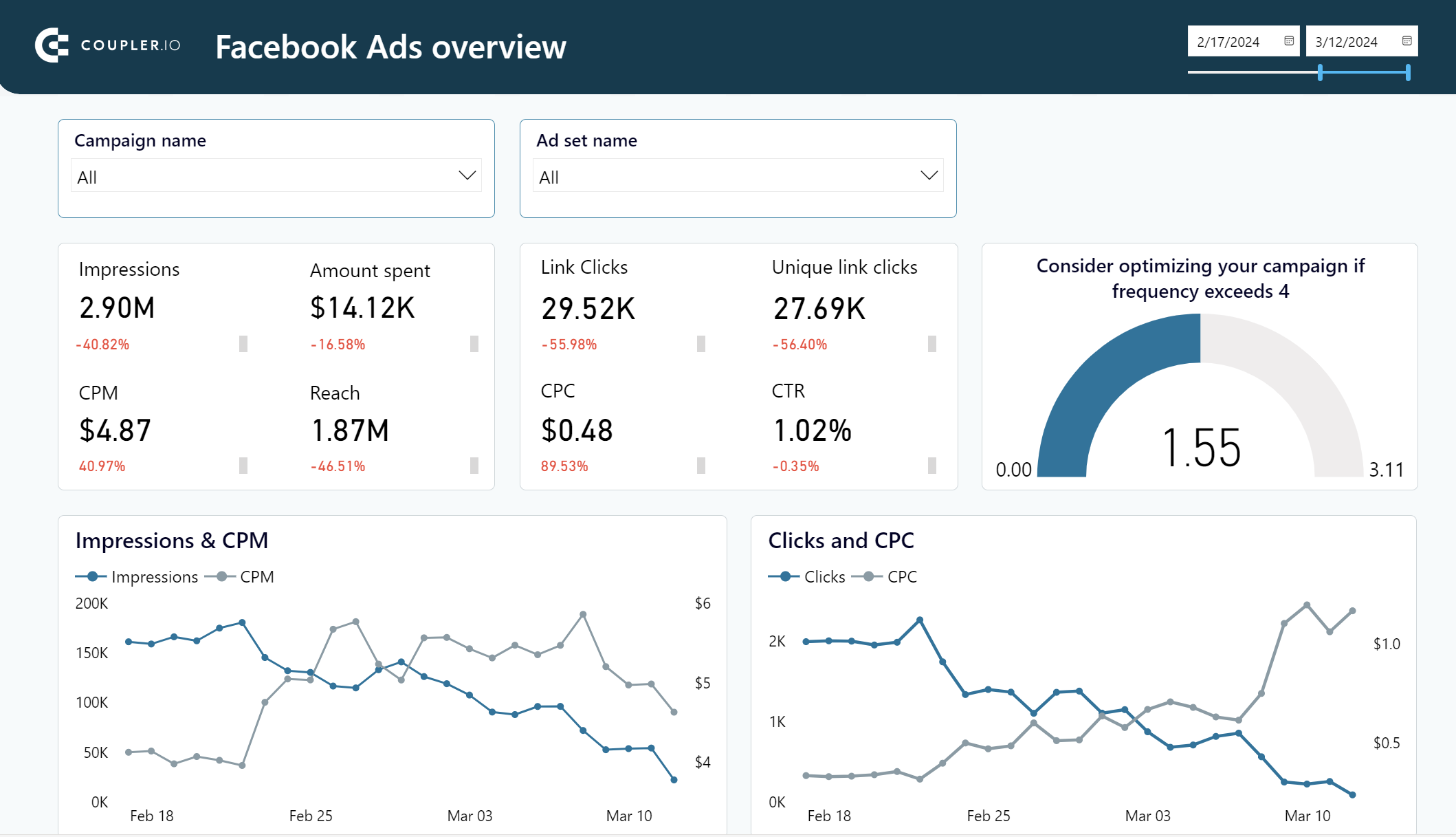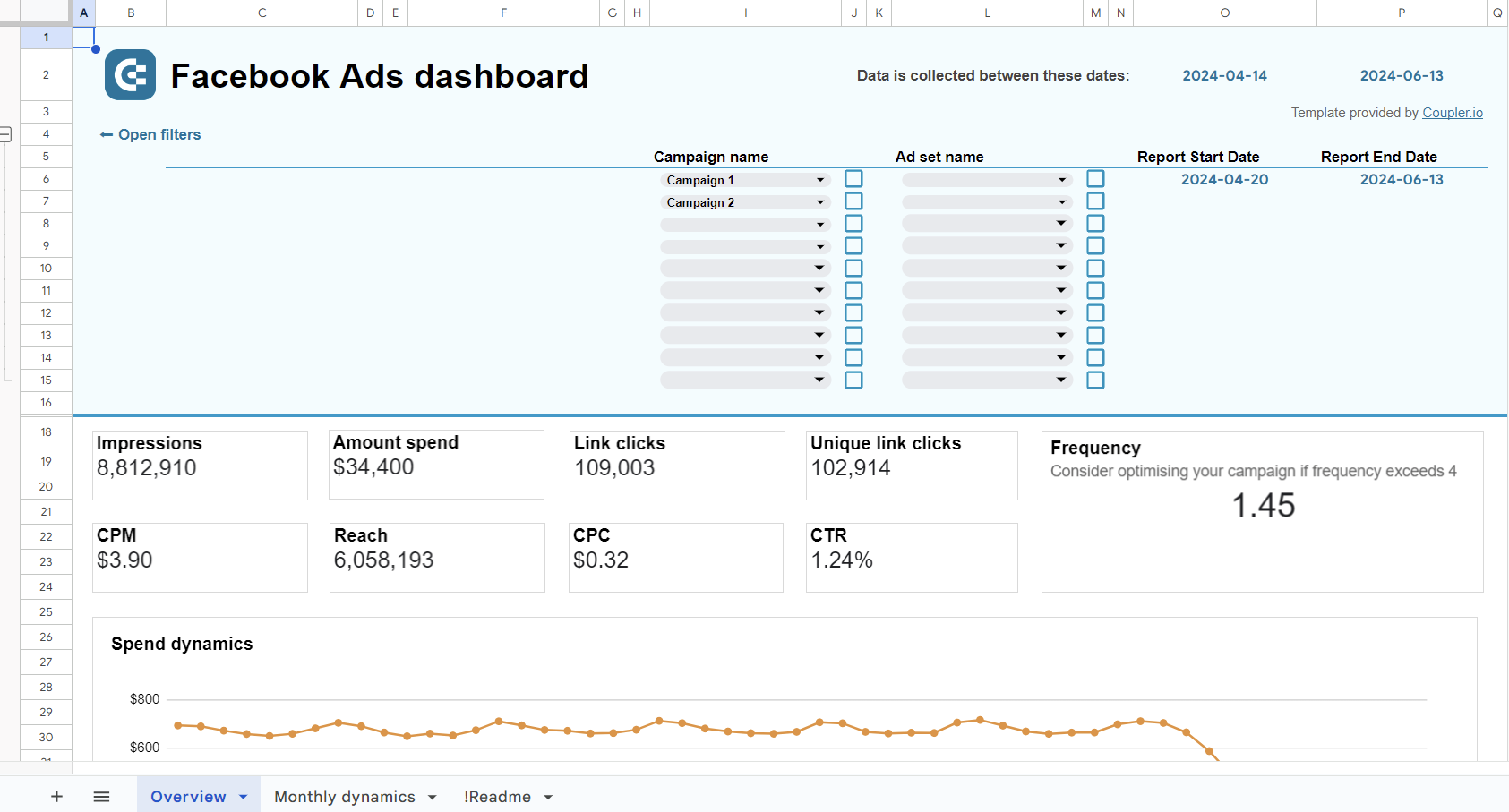You prepared brilliant designs, witty messages, and selected the perfect audience settings… but the conversion rate still doesn’t quite match the expectations. You’re not alone.
Usually, this happens because one (or several) of the most frequent issues are in play. In this blog post, we’ve put together a list of the 8 most common reasons why Facebook Ads are not converting. This will help you to identify the problem and fix it with our actionable tips based on hands-on experience.
Now, let’s get your conversions back on track.
Key reasons for Facebook Ads not converting and how to fix this
In a minute, we will explore possible issues and their fixes in detail.
But first, here’s a quick conversion rate troubleshooting checklist. If something goes wrong, start by asking these questions:
- Are conversion metrics being tracked correctly?
- Is your landing page up to date and working properly?
- Do your ad links get enough clicks?
- Is your CPM within the industry standards?
- Does your budget match your goals?
- Is the target audience relevant?
- Is the value proposition clear?
- Is your call to action catchy and informative?
- Does your ad include social proof?
So, if you already have an idea of what could be wrong with your conversions, you can jump right to the section that interests you. But still, we recommend you have a look at all the possible things to fix. This can help you improve your results, even if the main reason is just one.
Reason #1: Broken conversion tracking
Maybe your ads really aren’t converting well… or maybe the information on the conversions gets lost on the way to your campaign report. With Facebook Ads, the main reason for broken conversion tracking is issues with Meta Pixel (Facebook Pixel). This can be incorrect installation, an outdated version of Pixel, incorrect code placement on your website, and so on.
How to fix:
- See if Pixel is working. Go to the Meta Events Manager -> Overview tab. Then, check All Activity to see if Pixel works normally and registers conversion events. If you see no activity, this means Pixel is not firing.
- Check the Diagnostics. Navigate to the Meta Events Manager -> Diagnostics tab. Here, you will find information on issues you need to act on (if any).
- Go through the setup instructions. Check Meta Pixel setup best practices and go through the setup process step by step to see where you could’ve done something wrong.
- Try installing Meta Pixel Helper for Chrome. It’s a browser extension that can help you check whether you installed Pixel correctly and troubleshoot it.
Reason #2: Lack of timely metric analysis
It can also be the case that your ads are not converting well because you don’t analyze your metrics on an ongoing basis. When you track your Facebook Ads metrics closely (for example, in a live dashboard), you can quickly spot any issues with the campaign performance. This gives you an opportunity to promptly react to changes and make timely adjustments.
Timely analysis prevents budget loss and inefficiencies as it gives you maximum control over your ads. It can help you make your social media marketing campaigns more data-driven.
How to fix:
- Track metrics in a live dashboard. Visualized data is much easier to work with, and with live updates, you can see what’s happening in real-time.
- Use a ready-to-go template. Building a dashboard doesn’t have to be complicated. For example, you can use this free template for Facebook Ads to visualize your data in about 5 minutes. The template has a built-in Coupler.io connector that lets you easily populate the dashboard with your data. As a result, you’ll get a ready-to-use reporting solution to track and analyze your campaign performance. The dashboard is available in three versions: Looker Studio, Power BI, and Google Sheets.
- Analyze metrics on an ongoing basis. Decide on the set of the most essential metrics for your goals and keep a close eye on them. You can also check how other marketers read metrics for additional tips and ideas. For more details, see our article Top 10 Facebook Ads Metrics And How to Analyze Them.
Reason #3: Landing page isn’t user-friendly
Perhaps, this happened to you too… You click on an ad that promises you a specific product with a discount, but the ad takes you to the store’s main page with no signs of the offer that attracted you. Confused, you try searching their catalog of products, but soon decide it’s not worth the effort and leave. A similar scenario can happen with a site that doesn’t display correctly on mobile devices or just takes too long to load.
Apart from low conversions, another indicator of issues with a landing page is a high bounce rate.
How to fix:
- Check the coherency. Look at your messages from your customer’s eyes and check if everything is clear. What you promise to a user in your ad copy, the landing page should deliver.
- Improve navigation and UI. It should be super-obvious for your customer where to click to read more about the offer, select product parameters, and place the order. Don’t ask for unnecessary information, and make the process as simple as possible to enhance user experience.
- Analyze your funnel for insights. Check at what stages of the funnel things go wrong. If landing page visitors leave within seconds, the issue is likely with the design and/or messaging. If they abandon a cart already loaded with products, maybe the checkout process is confusing.
- Optimize for mobile devices. For an ad campaign run on a social media platform, mobile-first approach is a must. Make sure your landing page is optimized for smartphones and tablets. The design should look correct, menus and buttons should be big enough to tap on them, and the page should load quickly even with a poor internet connection. Landing page optimization can be very helpful for improving ad results.
- Improve your creatives. Last but not least – the landing page design should look professional and attractive. Messaging needs to be catchy, but clear and to the point.
Tip: To see better results across campaigns, I recommend optimizing your Facebook Ads funnel at every stage and not just fixing issues as they arise.
Reason #4: Low link-click through rate
Not all your website visitors will convert into customers. So to get good conversions, you need to get enough visitors first. This won’t happen if your ads have a low link-click through rate. In general, an issue with this metric indicates that the ad doesn’t motivate users to click. One of possible reasons for this can be that the ad is not relevant. For example, if you show an ad promoting accounting software to a 16-18 year old audience, they won’t click on it.
How to fix:
- Make sure your offer is competitive. If your competitors are targeting the same audience with a significantly better offer, yours can lose points.
- Experiment with design. Cluttered, unprofessional, or unattractive design can be the reason why your ads don’t get enough attention. Or maybe the design is fairly good, but it just doesn’t stand out in a newsfeed – this can also be an issue. Prepare several options and see which performs better.
- Improve the CTAs. Eye-catching, yet clear call to action and messaging in general is an important component of a successful Facebook Ads campaign. Here, it’s also useful to A/B test several options.
- Try different ad formats. For example, consider launching video ads addressing specific pain points of your audience, or launching a content marketing project. Variety is important, especially if your target market is competitive.
Reason #5: Too high CPM (Cost Per Mille)
If your CPM is too high, this means a thousand impressions cost you more than it should. This can mean that you are showing your ads to an unengaged audience – as a result, the conversions are low. So, most likely, either the audience is not quite right, or your ads fail to engage it.
How to fix:
- Revise your targeting settings. Double-check the audience profile and experiment with the targeting settings. It can also help to target narrower audience segments, preferably with customized ad creatives for each segment.
- Make your creatives more engaging. Creative assets should be just that – creative. It helps to brainstorm new ideas and try out different options.
- Conduct competitor analysis. See what your competitors are doing and analyze their strategy and creatives. This can help you understand how to make your ads stand out.
- Prevent ad fatigue. One of the possible reasons for an unengaged audience is that people already saw your ad multiple times and are not interested anymore. Use Facebook’s frequency capping feature to avoid this and refresh your creatives regularly.
Reason #6: Bid is too low
Maybe your targeting is to the point and your creatives are perfect, but you simply bid too low to get them in front of the audience. If your bid is not competitive, Facebook algorithm will likely choose to show someone else’s ads to your audience. Although bidding moderately helps optimize ad budget, make sure it’s not so low that it would stall your campaigns.
How to fix:
- Increase your bid. The trick is to make your bid high enough to get impressions, but still low enough for your ads to be profitable.
- Try out different bidding strategies. Experiment with different bidding options available on Facebook, such as CPC and CPR. A/B test the selected bidding strategies and see what works better.
- Consider increasing your ad budget. It’s also possible that you might need to increase your ad spend to achieve any results. It’s especially relevant if you are working in a highly competitive niche.
Reason #7: Wrong target audience
A common mistake is targeting a too broad audience, which is likely to be a cold audience. For example, you sell pet care products and target your ads to all women within the age range 15-45. In this group, there are probably a lot of women who don’t have pets. They won’t be interested in your ads, which will negatively affect your conversion rate. The good news is that the situation will improve once you find the right audience.
How to fix:
- Narrow your audience. In addition to demographic targeting, use interest targeting. In our example, you would need to reach people who expressed interest in pets, cat and dog food, and so on.
- Leverage behavioral targeting. For instance, people who recently visited pet-related websites or apps will be more likely to get interested in pet care products. So it makes sense to take this into account when setting up your targeting parameters. If you target custom audiences and utilize all the features Facebook Ads manager has to offer, this will help you improve ad performance.
- Conduct customer research. This will help you to better understand your customers’ interests and motivations. It’s best to develop several key customer personas and target each of them with a tailored campaign. When you know who your ideal customer is, it will be easier to craft more relevant ads. This will help you improve your audience targeting.
Another factor that can be stalling your conversions is that your ads don’t have enough credibility in the customers’ eyes. For most people, it’s important that a new product or service is recommended by someone. It also helps if a potential customer sees that a lot of people already bought this product. Most people also read reviews before buying something. If your ads don’t contain any “reasons to believe”, your audience might be less engaged.
How to fix:
- Add customer reviews and testimonials. Ask your customers what they think about your product and place their quotes on your website. User comments on review platforms and social media can also be helpful.
- Use numbers in your ads. For example, you can mention that your pet care products already “made 5000 dogs happy”. Or that your tech product “freed up 5 million hours” for your customers. Number of clients or the number of years you’ve been on the market can also add credibility.
- Show people behind your product. You can add photographs and short bios of your team on your website. This will help you build trust and credibility, especially if you add short quotations about why they are enthusiastic about their work. Experiment with different ad types to see what works best.
Bonus: Why are my Facebook Ads not converting in major cities?
In general, the main reasons for Facebook Ads not converting are pretty much the same everywhere. So you can use our list of top 8 reasons to troubleshoot your Facebook Ads campaigns regardless of the locations you are targeting.
However, there are some additional factors that can be in play when we are talking about Facebook marketing in big cities.
- Increased competition. The audience is huge, but the competition for its attention can be fierce. Your ads may underperform because your competitors bid higher or use more catchy creatives. It can be useful to consider different bidding strategies and conduct competitor analysis to see how you compare with the others.
- More mobile-first users. In the biggest cities, people tend to use mobile devices more heavily than people living in less fast-paced locations. This means the importance of mobile optimization here is even higher. Your ads must be easy to interact with on a small screen, and your landing page should be mobile-optimized as well.
- Too broad targeting. Even though all people in major cities can be your potential customers, it can be helpful to segment them into smaller geo groups and tailor a separate campaign for each of them. For example, you can craft a separate ad set for each city. Another option is to use hyperlocal targeting and target people in certain neighborhoods based on their location, interests, or events in that area. This will help you increase relevance.
Apart from that, all the general tips for effective digital marketing apply here as well. You can use retargeting and lookalike audiences, drive impressions, and keep an eye on your CTR and CPM. It’s also useful to make sure your budget corresponds with your campaign objective.
Track your Facebook Ads conversion in a white-label dashboard
As we’ve already mentioned, untimely or insufficient metric analysis can be one of the reasons for poor conversion. Working with your metrics in an interactive dashboard can help you prevent this issue. Here’s a free template for a Facebook Ads dashboard by Coupler.io.
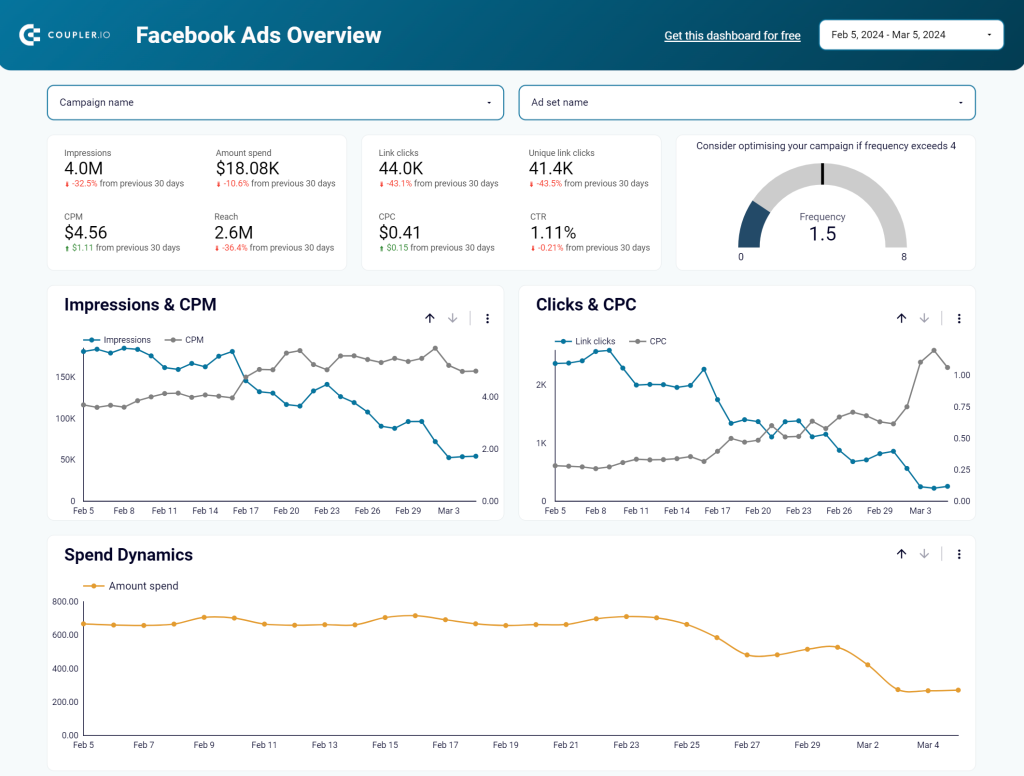
It allows you to:
- Track the frequency of Facebook ads. You can monitor the number of times one person saw your ad and filter this value for the whole account, per separate campaign, ad set, or time period.

- Monitor the dynamic of your progress in an easy-to-share way to simplify communication with stakeholders.
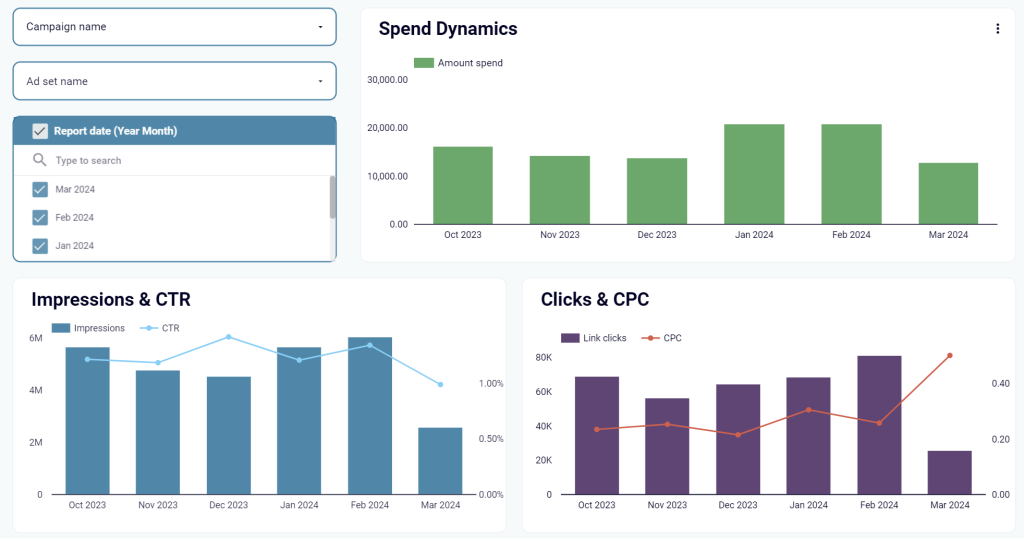
- Get insights into audience segments with the most clicks.

- Understand from which country the biggest part of the traffic comes to optimize targeting.
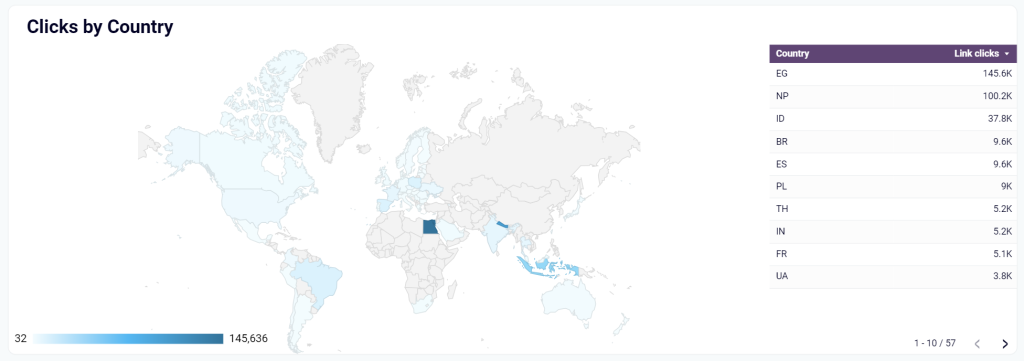
Using this dashboard, you can easily visualize your Facebook Ads data in 2 minutes. Follow the instructions provided in the Readme tab to connect your Facebook Ads account and load data to the dashboard.
The Facebook Ads dashboard template is available for Looker Studio, Power BI, and Google Sheets. Try the version that fits your reporting needs.
Now, you can start tracking your metrics in a self-updating dashboard. You can also customize this dashboard to your liking. If needed, you can use Looker Studio’s native functionality to add more metrics, include additional graphs, add your logo, and so on.
Additionally, you can build a brand awareness dashboard for Facebook Ads and GSC to better understand your campaign impact.
Conclusion: if Facebook Ads don’t convert, improve your campaigns all around
When Facebook Ads don’t convert, this issue needs to be tackled comprehensively. Even though there may be one main factor that impacts your results the most, it’s still likely that the issue is not down to just one reason. So, making consistent improvements in every component of your ad campaigns is a great way to make sure your Facebook ads have the best chance to perform well and drive conversions.
That’s why it makes sense to enhance every aspect of your campaigns – from improving ad creatives and landing pages to revising your ad budget and experimenting with bidding strategies. And, of course, double-checking conversion tracking and regularly analyzing your metrics is a must.
We hope our tips will help you to make your Facebook Ads campaigns a success. For more on this topic, see our article on how to optimize Facebook Ads and Facebook Ads reporting.
Good luck with Facebook advertising!
Automate Facebook Ads reporting with Coupler.io
Get started for free

